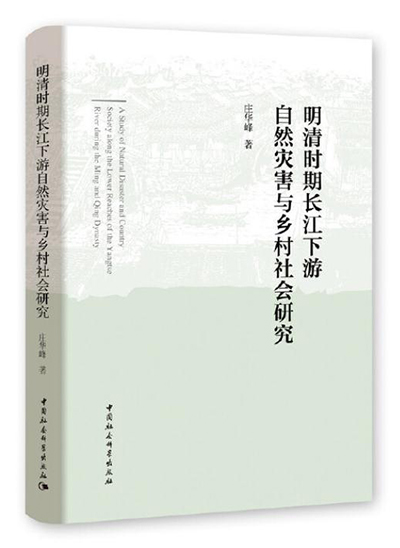Natural disaster and country society in Ming and Qing

A Study of Natural Disaster and Country Society Along the Lower Reaches of the Yangtze River During the Ming and Qing Dynasties
A Study of Natural Disaster and Country Society Along the Lower Reaches of the Yangtze River During the Ming and Qing Dynasties, authored by Zhuang Huafeng, a professor from the School of History at Anhui Normal University, focuses on the linkage between natural disasters and rural society.
It clarifies disasters’ diffusion process, evolution law, and characteristics at various levels of rural society in Jiangnan [regions south of the Yangtze River], the mechanism, characteristics, and effectiveness of governmental and nongovernmental response to disasters, as well as the changes in the linkage mechanism between disasters and rural society.
The total outbreaks of natural disasters in the lower reaches of the Yangtze River during the Ming (1368–1644) and Qing (1644–1911) dynasties, including floods, droughts, plagues of locusts and other pests, storm tides, hail, snow disasters, earthquakes, and epidemics, were 5,964, with 2,822 in Ming and 3,142 in Qing respectively, an average of 10.96 per year. Among them, floods and droughts were the most frequent, and they had the longest duration and the highest degree stricken, showing relatively concentrated regional distribution.
When farmers could hardly survive, social instability factors continued to ferment, causing such problems as the prevalence of panic scramble for rice, refusal to pay grain taxes and other taxes, rampant local banditry, frequent unrest of disaster victims, and continuous lawsuits and disputes over water conservancy. The correlation between disaster frequency and regional social, political, and economic changes shows that natural disasters were not simply caused by natural factors, but also closely related to social factors such as population aggregation, economic development, and heavy taxation.
In the Ming and Qing, the population of Jiangnan increased sharply, which greatly exceeded the bearing capacity of natural environments. In addition, the region was located in a monsoon climate zone, with wide and deep waters. Affected by the monsoon climate and the inflow of water from the upper and middle reaches, the region was very susceptible to “entering a disordered state,” which directly triggered population changes, social conflicts, the collapse of rural order, etc.
In the Ming and Qing era, various types of disaster relief mechanisms coexisted, dominated by the imperial court. Yet flawed decision-making and bureaucratic corruption caused man-made disasters to follow natural disasters, leading to the superimposition and ubiquity of disasters. In addition, unreasonable exploitation, especially of reclaiming land around lakes and indiscriminate deforestation, resulted in irreversible damage to the ecology, while soil and water erosion directly led to frequent floods and droughts, forming a vicious cycle.
Yu Tongyuan is a professor from the School of Sociology at Soochow University.
Edited by YANG LANLAN
